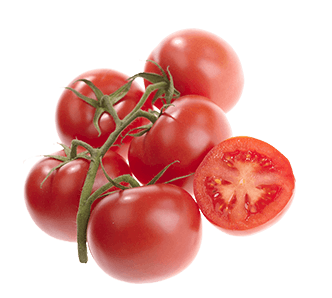Lycopene - a carotenoid used as an anti-oxidant and radical quencher
 Lycopene is a linear tetraterpene with two non-conjugated and 11 conjugated unsaturated bonds, which give it a red colour. The carotenoid is present in most red plants and fruits. Lycopene is used as an anti-oxidant and as a radical quencher.
Lycopene is a linear tetraterpene with two non-conjugated and 11 conjugated unsaturated bonds, which give it a red colour. The carotenoid is present in most red plants and fruits. Lycopene is used as an anti-oxidant and as a radical quencher.
The Lycopene extract is derived from Fructus Lycopersici Esculenti, a special type of tomato. The plant is rich on carotenoids and is especially known for its content of Lycopene.
Because of its acrylic structure, it is very hydrophobic and the intestinal absorption of Lycopene requires the presence of bile salts and fat to form micelles. From oily dietary supplements it can be more efficiently absorbed than from food. The absorption can be enhanced by the presence of dietary fat and by cooking. The average intake of Lycopene from food is rather high in Greece and Southern Spain, because of the Mediterranean diet. It is on the low side in Middle and North Europe making a supplementation advisable.

|
| Lycopene structural formula |
Positive health effects of Lycopene
Lycopene is the most active radical scavenger from the different carotenoids, like astaxanthin, zeaxanthin and Lutein. It is very efficient in protecting DNA from damage through oxygen or light. Thus, it is not surprising that Lycopene can lower the risk of macular degeneration and cataract, and that low blood levels of Lycopene have been linked to a higher risk of age-related macular degeneration. In addition, in several studies Lycopene showed a protective effect against different types of cancer like breast, skin or lung cancer. Furthermore high plasma levels of Lycopene can help to reduce the risk to suffer from the metabolic syndrome. This effect is linked to the anti-inflammatory, lipid-modulatory and anti-oxidative effects of Lycopene. In addition, Lycopene showed to be beneficial in various other diseases, e.g. male infertility, liver disorders and pancreatitis.
For supplementation a daily dose of 5 mg to 50 mg is recommended, whereas also a higher intake is considered as safe. Lycopene is also used as a food dye. In the EU it is permitted with the number
E 160d.
Product range
We offer Lycopene in a wide range of different forms:
|
||||||||||
|
|
| Packing: | 1 kg or 5 kg aluminium-foil bag/ 20 kg or 25 kg drum |
| Shelf life: | 2 years |
| Storage: | Store in a well-closed place with constant low temperature and no direct sun light. |
Identifier
| CAS-No.: | 502-65-8 |
| INCI: | Lycopene |

